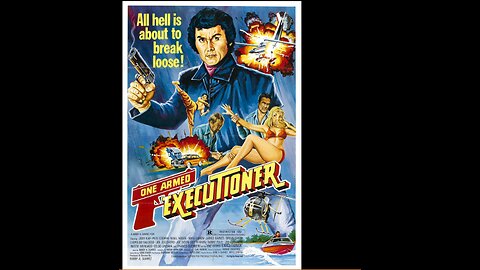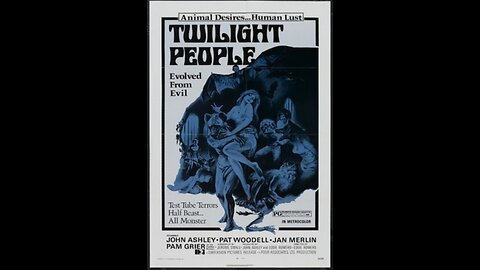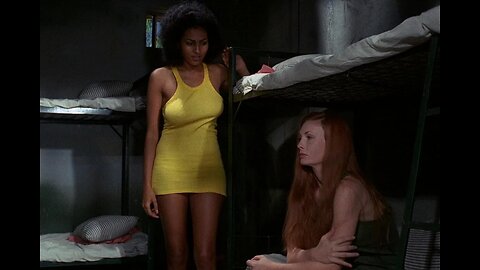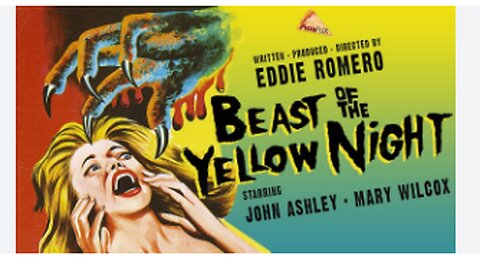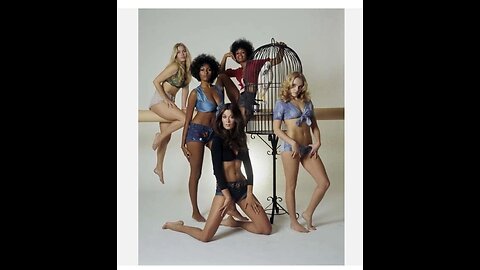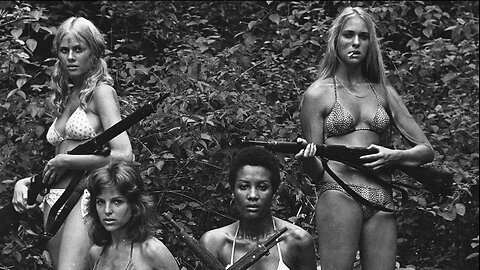
Filipino Exploitation Cinema
6 videos
Updated 2 months ago
Exploitation Films made in the Philippines. Filipino exploitation films are low-budget, commercially-focused movies, especially prominent in the 1970s, often made in collaboration with American producers and focusing on genres like women-in-prison and blaxploitation. Key films include Roger Corman's productions like Big Doll House (1971) and Women in Cages (1971), as well as Eddie Romero's Terror Is a Man (1959) and the Blood Island series. These films utilized existing Philippine production networks and challenged the idea that such low-budget films were distinct from serious national cinema.
-
Filipino Exploitation Cinema Machete Maidens Unleashed Documentary
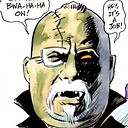 MemoryCryptofCastleHillsA fast moving odyssey into the subterranean world of the rarely explored province of Filipino genre filmmaking. Director: Mark Hartley Writers: Mark Hartley, Andrew Leavold Stars: Roger Corman, John Landis, Pete Tombs170 views
MemoryCryptofCastleHillsA fast moving odyssey into the subterranean world of the rarely explored province of Filipino genre filmmaking. Director: Mark Hartley Writers: Mark Hartley, Andrew Leavold Stars: Roger Corman, John Landis, Pete Tombs170 views -
Filipino Exploitation Cinema: The One Armed Executioner (1983)
 MemoryCryptofCastleHillsFilipino Exploitation Cinema: The One Armed Executioner (1983) The One Armed Executioner 1981 Rated R The One Armed Executioner (1981) Interpol agent-turned-restaurateur Ramon Ortega overcomes loss and addiction to master martial arts and seek revenge. Director: Bobby A. Suarez Writers: Ray Hamilton, Bobby A. Suarez Stars: Franco Guerrero, Jody Kay, Mike Cohen113 views
MemoryCryptofCastleHillsFilipino Exploitation Cinema: The One Armed Executioner (1983) The One Armed Executioner 1981 Rated R The One Armed Executioner (1981) Interpol agent-turned-restaurateur Ramon Ortega overcomes loss and addiction to master martial arts and seek revenge. Director: Bobby A. Suarez Writers: Ray Hamilton, Bobby A. Suarez Stars: Franco Guerrero, Jody Kay, Mike Cohen113 views -
Filipino Exploitation Cinema: 1972 The Twilight People
 MemoryCryptofCastleHillsThe Twilight People is a 1972 Filipino-American horror film directed by Eddie Romero. It was produced by Romero and John Ashley, and written by Romero and Jerome Small. It stars Ashley and features, in an early film appearance, Pam Grier in a supporting role. While diving, Matt Farrell (Ashley) is kidnapped by Neva Gordon (Pat Woodell) and Steinman (Jan Merlin) and taken to an island where Neva's father Dr. Gordon (Charles Macaulay) is experimenting, trying to make a "super race" by combining humans and animals. Dr. Gordon wants Farrell to be one of his upcoming experiments, but Neva begins to doubt her fathers' work following a botched experiment on another test subject and falling in love with Farrell. She decides to help Farrell and the animal people escape. Steinman and his men hunt them down. Director Romero had previously produced 1959's Terror Is a Man, closely based on H. G. Wells' The Island of Doctor Moreau, and returned to the same subject matter with The Twilight People, although neither film acknowledged their source material. The film, which is also known as Island of the Twilight People, was originally made for New World Pictures, then run by Roger Corman and Lawrence Woolner. Corman, Wollner and actor/producer Ashley had previously worked together on Beast of the Yellow Night, The Big Doll House and The Woman Hunt. They came up the idea of making a new modern-day version of the Wells classic over lunch one day. Ashley said that they wrote the script and started filming one month after the initial lunch. When Corman and Woolner decided to dissolve their partnership, Woolner took Twilight People to his new distribution company, Dimension Pictures. The film's budget was US$150,000.00. The Philippines-based production company, Four Star Associates, Ltd., was owned by Romero. The film was shot by Fredy Conde and edited by Ben Barcelon; Ariston Avelino and Tito Arevalo handled the score.102 views
MemoryCryptofCastleHillsThe Twilight People is a 1972 Filipino-American horror film directed by Eddie Romero. It was produced by Romero and John Ashley, and written by Romero and Jerome Small. It stars Ashley and features, in an early film appearance, Pam Grier in a supporting role. While diving, Matt Farrell (Ashley) is kidnapped by Neva Gordon (Pat Woodell) and Steinman (Jan Merlin) and taken to an island where Neva's father Dr. Gordon (Charles Macaulay) is experimenting, trying to make a "super race" by combining humans and animals. Dr. Gordon wants Farrell to be one of his upcoming experiments, but Neva begins to doubt her fathers' work following a botched experiment on another test subject and falling in love with Farrell. She decides to help Farrell and the animal people escape. Steinman and his men hunt them down. Director Romero had previously produced 1959's Terror Is a Man, closely based on H. G. Wells' The Island of Doctor Moreau, and returned to the same subject matter with The Twilight People, although neither film acknowledged their source material. The film, which is also known as Island of the Twilight People, was originally made for New World Pictures, then run by Roger Corman and Lawrence Woolner. Corman, Wollner and actor/producer Ashley had previously worked together on Beast of the Yellow Night, The Big Doll House and The Woman Hunt. They came up the idea of making a new modern-day version of the Wells classic over lunch one day. Ashley said that they wrote the script and started filming one month after the initial lunch. When Corman and Woolner decided to dissolve their partnership, Woolner took Twilight People to his new distribution company, Dimension Pictures. The film's budget was US$150,000.00. The Philippines-based production company, Four Star Associates, Ltd., was owned by Romero. The film was shot by Fredy Conde and edited by Ben Barcelon; Ariston Avelino and Tito Arevalo handled the score.102 views -
Filipino Exploitation Cinema The Big Doll House (1971)
 MemoryCryptofCastleHillsThey Call Him Chop Suey. They Call Her Cleopatra Wong. They also called them cheap trash. Low-quality American-produced ‘70s movies for kids to make out to in drive-ins and small town cinemas. But they were also some of the most fun films ever to come out of the Philippines. Not that any American teen could’ve cared any less where the movies were filmed as long they had the three Bs in them. Among foreign films shot in the Philippines, Apocalypse Now is, of course, the most highly acclaimed. Born on the Fourth of July, starring Tom Cruise, is a contender. Most, however, didn’t have notable actors or directors attached to them. (Unless you count Chuck Norris, or cult B movie directors like Roger Corman.) It was cheap labor, access to film crews and equipment and, in Francis Ford Coppola’s case, helicopters and pilots courtesy of President Ferdinand Marcos, which led low-budget movie producers to come here. The fact that American filmmakers weren’t welcome in post-war Vietnam didn't hurt either. Standing in for other tropical locations, the filmmakers would often, whether by design or not, obscure their actual settings. The jungles of Quezon province and beaches of Baler became the homes of crazed American doctors, the Viet Cong, even Satan himself. Filipino henchmen’s voices were dubbed to sound stereotypically Chinese, female Filipino prison guards were the “best gunslingers south of Pango Pango,” and black pirates attacked remote Philippine islands. Sometimes, Filipinos remained behind the camera, directing American actors. The Big Doll House is a 1971 American women-in-prison film starring Pam Grier, Judy Brown, Roberta Collins, Brooke Mills, and Pat Woodell. The film follows six female inmates through daily life in a gritty, unidentified tropical prison. Later the same year, the film Women in Cages featured a similar story and setting and much the same cast, and was shot in the same abandoned prison buildings. A nonsequel follow-up, titled The Big Bird Cage, was released in 1972. Director: Jack Hill Writer: Don Spencer Stars: Pam Grier, Sid Haig, Roberta Collins, Judith Brown219 views
MemoryCryptofCastleHillsThey Call Him Chop Suey. They Call Her Cleopatra Wong. They also called them cheap trash. Low-quality American-produced ‘70s movies for kids to make out to in drive-ins and small town cinemas. But they were also some of the most fun films ever to come out of the Philippines. Not that any American teen could’ve cared any less where the movies were filmed as long they had the three Bs in them. Among foreign films shot in the Philippines, Apocalypse Now is, of course, the most highly acclaimed. Born on the Fourth of July, starring Tom Cruise, is a contender. Most, however, didn’t have notable actors or directors attached to them. (Unless you count Chuck Norris, or cult B movie directors like Roger Corman.) It was cheap labor, access to film crews and equipment and, in Francis Ford Coppola’s case, helicopters and pilots courtesy of President Ferdinand Marcos, which led low-budget movie producers to come here. The fact that American filmmakers weren’t welcome in post-war Vietnam didn't hurt either. Standing in for other tropical locations, the filmmakers would often, whether by design or not, obscure their actual settings. The jungles of Quezon province and beaches of Baler became the homes of crazed American doctors, the Viet Cong, even Satan himself. Filipino henchmen’s voices were dubbed to sound stereotypically Chinese, female Filipino prison guards were the “best gunslingers south of Pango Pango,” and black pirates attacked remote Philippine islands. Sometimes, Filipinos remained behind the camera, directing American actors. The Big Doll House is a 1971 American women-in-prison film starring Pam Grier, Judy Brown, Roberta Collins, Brooke Mills, and Pat Woodell. The film follows six female inmates through daily life in a gritty, unidentified tropical prison. Later the same year, the film Women in Cages featured a similar story and setting and much the same cast, and was shot in the same abandoned prison buildings. A nonsequel follow-up, titled The Big Bird Cage, was released in 1972. Director: Jack Hill Writer: Don Spencer Stars: Pam Grier, Sid Haig, Roberta Collins, Judith Brown219 views -
Filipino Exploitation Theater: Beast of the Yellow Night (1971)
 MemoryCryptofCastleHillsBeast of the Yellow Night is a 1971 horror film, directed by Eddie Romero and starring John Ashley, who co-produced the film with Romero. It was the fourth release for Roger Corman's distribution company New World Pictures. It was released as a double feature with the West German horror film, Creature with the Blue Hand. After successfully distributing Beast of Blood in 1970, producer Kane W. Lynn (as Hemisphere Pictures) tried to get the distribution rights to Ashley's next horror film, titled Beast of the Yellow Night. Ashley and his production company Four Associates Ltd. put up the money to produce the film themselves in the Philippines, and instead of allowing Lynn to distribute it, he made a deal with Roger Corman's then-fledgling New World Pictures instead. Lynn's ex-business partner in Hemisphere Pictures, Eddie Romero, was hired to direct and co-produce, but Lynn was cut out of the deal. Ashley's Four Associates Ltd. went on to produce several other films in the Philippines, such as The Twilight People, The Woman Hunt and Ebony, Ivory & Jade, before disbanding. Lynn invested in Sam Sherman's 1971 sci-fi film Brain of Blood, which did not fare well, and died soon after of cancer in 1975. Ashley said that playing the role of the monster "was a lot of fun to do. I used a double in the long shots but the scenes where the beast was talking...was me." Ashley later said that the film was among the better written of his Philippines films. "It certainly was the most cerebral, if you can call any of those pictures that", he said. The success of the movie led Corman to make a series of films in the Philippines, including The Big Doll House.96 views
MemoryCryptofCastleHillsBeast of the Yellow Night is a 1971 horror film, directed by Eddie Romero and starring John Ashley, who co-produced the film with Romero. It was the fourth release for Roger Corman's distribution company New World Pictures. It was released as a double feature with the West German horror film, Creature with the Blue Hand. After successfully distributing Beast of Blood in 1970, producer Kane W. Lynn (as Hemisphere Pictures) tried to get the distribution rights to Ashley's next horror film, titled Beast of the Yellow Night. Ashley and his production company Four Associates Ltd. put up the money to produce the film themselves in the Philippines, and instead of allowing Lynn to distribute it, he made a deal with Roger Corman's then-fledgling New World Pictures instead. Lynn's ex-business partner in Hemisphere Pictures, Eddie Romero, was hired to direct and co-produce, but Lynn was cut out of the deal. Ashley's Four Associates Ltd. went on to produce several other films in the Philippines, such as The Twilight People, The Woman Hunt and Ebony, Ivory & Jade, before disbanding. Lynn invested in Sam Sherman's 1971 sci-fi film Brain of Blood, which did not fare well, and died soon after of cancer in 1975. Ashley said that playing the role of the monster "was a lot of fun to do. I used a double in the long shots but the scenes where the beast was talking...was me." Ashley later said that the film was among the better written of his Philippines films. "It certainly was the most cerebral, if you can call any of those pictures that", he said. The success of the movie led Corman to make a series of films in the Philippines, including The Big Doll House.96 views -
Filipino Exploitation Cinema: Pam Grier sizzles on screen in The Big Birdcage 1972
 MemoryCryptofCastleHillsThe Big Bird Cage is a 1972 American exploitation film of the "women in prison" subgenre. It serves as a non-sequel follow-up to the 1971 film The Big Doll House. The film was written and directed by Jack Hill, and stars Pam Grier, Sid Haig, Anitra Ford, and Carol Speed. Blossom, a buxom bad girl, is the rough-and-ready girlfriend of a radical guerrilla leader, Django. She keeps her relationship a secret, but is also quick to start a fight without knowing it. However, when Django's mercenary friends itch for some female companionship, she softens and the two devise a plan to liberate the inmates of a local women's prison, where the inmates are kept barefoot and subjected to brutally hard labor. A woman named Terry, a social climber, ends up in the prison herself because of Blossom and Django's earlier robbery. She is now forced to deal with crazy inmates, gay guards, and torture of the cage. Terry, Blossom, and Django (who busted in by seducing Rocco, one of the guards) eventually come together to face off against the warden Zappa to stage an explosive breakout.195 views
MemoryCryptofCastleHillsThe Big Bird Cage is a 1972 American exploitation film of the "women in prison" subgenre. It serves as a non-sequel follow-up to the 1971 film The Big Doll House. The film was written and directed by Jack Hill, and stars Pam Grier, Sid Haig, Anitra Ford, and Carol Speed. Blossom, a buxom bad girl, is the rough-and-ready girlfriend of a radical guerrilla leader, Django. She keeps her relationship a secret, but is also quick to start a fight without knowing it. However, when Django's mercenary friends itch for some female companionship, she softens and the two devise a plan to liberate the inmates of a local women's prison, where the inmates are kept barefoot and subjected to brutally hard labor. A woman named Terry, a social climber, ends up in the prison herself because of Blossom and Django's earlier robbery. She is now forced to deal with crazy inmates, gay guards, and torture of the cage. Terry, Blossom, and Django (who busted in by seducing Rocco, one of the guards) eventually come together to face off against the warden Zappa to stage an explosive breakout.195 views
